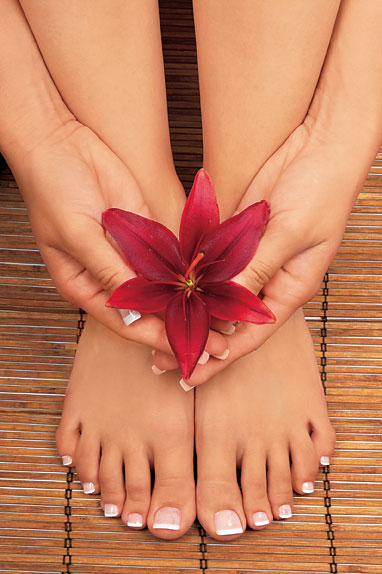Head Over Heels—Put your best foot forward with these podiatric tips
By Karen Dix
February 2012 View more Health & Fitness
 The American Podiatric Medical Association (APMA) says Americans rank the foot lowest on a list of body parts important to their well being—yet we report more pain and problems with our feet than anything else. Our poor feet faithfully endure impact, rough terrain, and ill-fitting shoes all day and when they protest, we ignore their pleas until we have to surrender into the nearest chair.
The American Podiatric Medical Association (APMA) says Americans rank the foot lowest on a list of body parts important to their well being—yet we report more pain and problems with our feet than anything else. Our poor feet faithfully endure impact, rough terrain, and ill-fitting shoes all day and when they protest, we ignore their pleas until we have to surrender into the nearest chair.
Agony of the Feet
“Foot pain is never normal,” says podiatrist Marlene Reid, M.D. of the Advanced Ankle and Foot Care Center. However, a little prevention can go far in keeping our feet healthy and comfortable.
One of the most common conditions Dr. Reid sees is plantar fasciitis, a heel pain caused by strain and inflammation of the ligaments at the bottom of the foot. Common among middle-aged individuals, the condition begins as a slight heel discomfort but grows intolerable in two to three months. “By then the condition becomes much harder to treat, so it’s important to come in early,” she says. One way to avoid the problem is to deliberately choose shoes with a stiff, supportive, unbendable heel counter (the part that supports the heel) for regular wear. In summer, Dr. Reid sees plantar fasciitis exacerbated by flip flops, but in winter, people kick off their boots and spend hours inside without shoes, which can also aggravate the condition. “Put on your athletic shoes inside so your heel is properly supported,” she says.
Wearing fashionable shoes without proper heel and arch support also can result in problems, says Dr. Reid. Don’t want to part with the stilettos? She suggests alternating heel heights daily so that the pressure points on the foot change regularly and are less likely to cause problems.
The Athlete’s Foot
Proper stretching and correct footwear can help prevent athletic injuries, according to Dr. O. Kent Mercado of Mercado Foot and Ankle Center. He sees many 35- to 55-year-old female patients who incur running injuries. As a marathon runner himself, Dr. Mercado says shoes should be selected based on the sport and on the individual’s gait. “A long-distance runner will need more cushion, while a sprinter will need more heel support,” he says. An athlete’s pronation, or the way the foot rolls in off the heel when it strikes a surface, should also be considered in fitting athletic shoes. Dr. Mercado suggests purchasing shoes at a running store that can give you a professional fitting.
“I also see an increasing amount of nine- to 12-year-old girls with injuries from jumping sports,” says Dr. Mercado, explaining that excessive impact can cause muscle strain and repetitive stress on the heel’s growth plate causing calcaneal apophysitis, or sever disease, characterized by painful tenderness in the heel. Again, proper sports-specific stretching before play can help prevent it, he says. Luckily, the condition can be treated conservatively, without surgery.
Another common complaint is toe fungus, which causes thickening or yellowing of the toenail. Since fungii thrive in warm, moist, dark places—like sweaty winter boots—be sure to wash your feet regularly, change socks frequently, and protect your feet with shower thongs in the locker room, says Dr. Mercado. Dr. Reid suggests thoroughly drying those boots over the heat register to completely eliminate moisture. Catching the problem early is important, and help is available, including a new laser treatment.
Prevention is the best way to avoid foot problems, but when you need a podiatrist, the sooner you go, the sooner you’ll be back on your feet.


